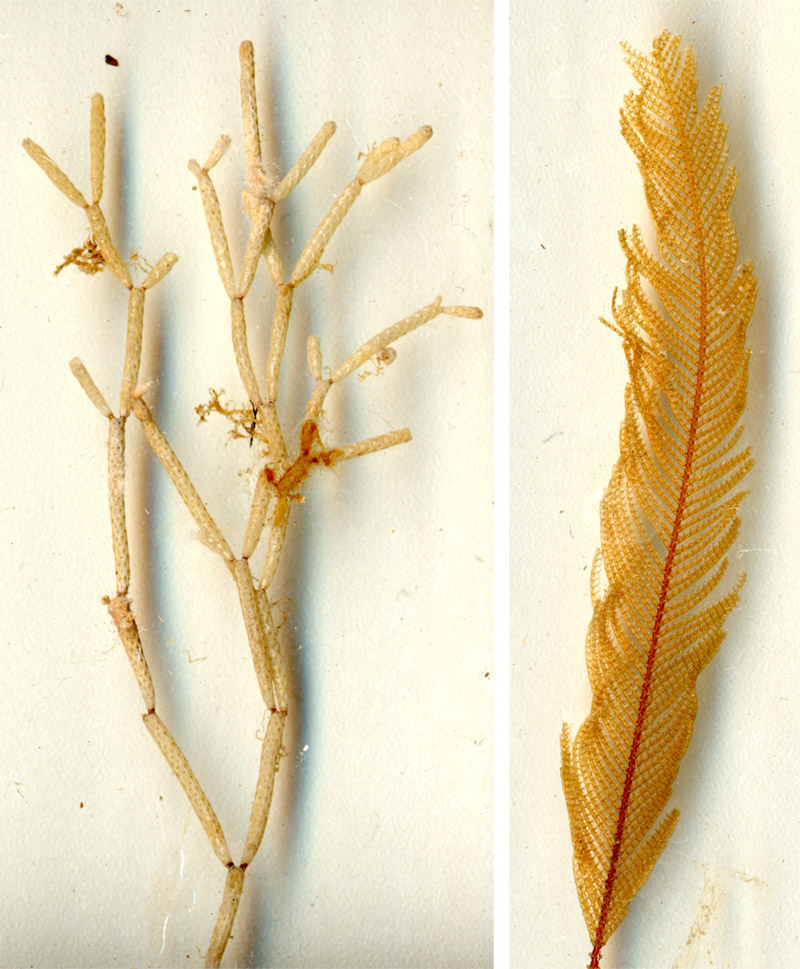Ferdinand Richard Brauer, 1845 – 1905
by Brian Stevenson
last updated August, 2010
This amateur microscopist made
large numbers of permanent slides of zoophytes, including many beautiful dry
mounts (Figures 1, 2 and 3). To make these slides, Brauer attached the base of
the zoophyte to a glass slide with a small drop of glue. He then glued thin
strips of cardboard to the edges of that slide. A second slide was then glued
to the cardboard spacers. The deep space thus created allowed the specimen to
retain its three-dimensional structure. Those preparations are still
fascinating to examine through a microscope, while also being very attractive
to the naked eye.

Figure 1. Examples of zoophyte slides prepared by Richard
Brauer. All five are standard 1 x 3 inch slides. He did not place his name on
most of the slides, as would be expected if these were from his personal
collection. Fortunately, he put his name on one label, apparently using an ink
stamp.

Figure 2. Additional microscope slides of zoophytes by Brauer.
The four on the left are dry mounts, in which he used 1 1/2 x 3 inch slides. Bauer
used this larger size of slide to full effect. The slide on the right is a balsam
mount on a 1 x 3 inch slide, which was obtained along with the illustrated dry mounts. The handwriting similar to that on Brauer’s small dry mounts (Fig. 1).
Almost all published records of Brauer
name him ‘Richard Brauer’, although his 1871 marriage record gives his full
name as ‘Ferdinand Richard Brauer’. According to information
he gave census takers, he was born in 1845 in Leipzig, in the Germanic state of
Saxony. I was unable to find Brauer in any English census prior to 1881.
However, he married Sara Wellard two months after the 1871 census was taken, so
presumably he lived in England at the time of the 1871 census. His name was
probably mis-transcribed. Richard and Sara had two children over the next 3
years, a son, Frederick, and a daughter, Eveline.
On the 1891 and 1901 censuses, Brauer gave described his occupation as engineer and manager
of a machinery import company. A reasonable conclusion is that Brauer moved
from Germany to England to manage a German company’s sales to Great Britain.
The first record of Brauer’s
interests in microscopy was an 1879 exchange offer in Hardwicke’s Science-Gossip “Wanted,
standard work on Entomology, or microscopic marine objects (unmounted): offered
French ½ inch triple objective; sketches of British insects by Houghton (quite
new), L. Clarke’s microscopic objects, slides, &c. – R. Brauer, Cresswell
Grove, Albert Park, Didsbury, Manchester”. He did not advertise exchanges in any other issues of that popular science magazine.
The following year, Brauer was involved in formation of the Manchester Microscopical Society, being a charter member.
He is recorded as having exhibited “marine algae and zoophytes” to
the Society on December 16, 1880. He also showed “marine algae from the Isle of Man, and zoophytes from the Channel
Islands and St. Anne's-on-the-Sea” at the October, 1882 meeting. Brauer had
other interests, such as the hermit crab and sea spider specimens he exhibited
April 6, 1882, and British and foreign beetles exhibited in 1901.
Richard Brauer was also a founding member of the Manchester Entomological Society. He made numerous presentations to that Society, including exhibits of microscope slides of insects.
The Manchester Microscopical Society summed up Brauer as follows:
“the Society has sustained a loss through the death of Mr. Richard Brauer, who passed away at his residence in Knutsford on
the 17th July, 1905. Mr. Brauer became a member of
the Society in 1880, the year of its formation. In 1895, he was appointed
Treasurer, and held the office until 1905, when pressure of business and
failing health compelled him to resign.
He had a knowledge much above the average of the construction uses of
the Microscope, and one of his favourite demonstrations was the
"Polarisation of Light," illustrated by many well executed diagrams.
He was a member of the Mounting Section and also of the Extension Section, to
each of which he contributed interesting information. Though of a somewhat
retiring disposition he was always ready to assist in the work of the Society.
Mr. Brauer possessed a fair collection of
mounted Zoophytes, the result of holiday work at the sea-side, and a handsome
collection of Lepidoptera, Coleoptera and Orthoptera, which he loved to exhibit
at the meetings. The Manchester Entomological Society claims him as one of its
original members.
A Special Meeting was to have been held on September 28th, to formally
present him with an illuminated address, together with a Camera and a small
collection of microscopical slides, prepared by members, as a mark of
appreciation of a record term of service as Treasurer and usefulness to the
Society. Mr. Brauer was pleased to enjoy the use of
the camera early on in the year.
Gifted with a musical talent he displayed ability as a pianist
.”

Figure 3. Close-up views of two zoophyte preparations by
Richard Brauer. His deep, dry mount preparations have held up remarkably well
for more than 110 years, and are still striking to examine both with and without
a microscope.
Resources
Annual Report and Transactions, Manchester Microscopical
Society (1900)
Annual Report and Transactions, Manchester Microscopical
Society (1906) page 78
The Entomologist (1903) Vol. 37, pages 28, 91-92 and 171-172
The Entomologist (1904) Vol. 38, pages 70 and 167
Hardwicke’s Science-Gossip (1879) Exchange offers, Vol. 15,
page 264
Microscopical News and
Northern Microscopist (1881), Notices of
Meetings, Vol. 1, pages 39-40
Microscopical News and
Northern Microscopist (1882), Notices of
Meetings, Vol. 2, pages 126 and 318-319
Vital statistics of England,
accessed through ancestry.co.uk
The Yearbook of the
Scientific and Learned Societies of Great Britain and Ireland (1904) page 138


